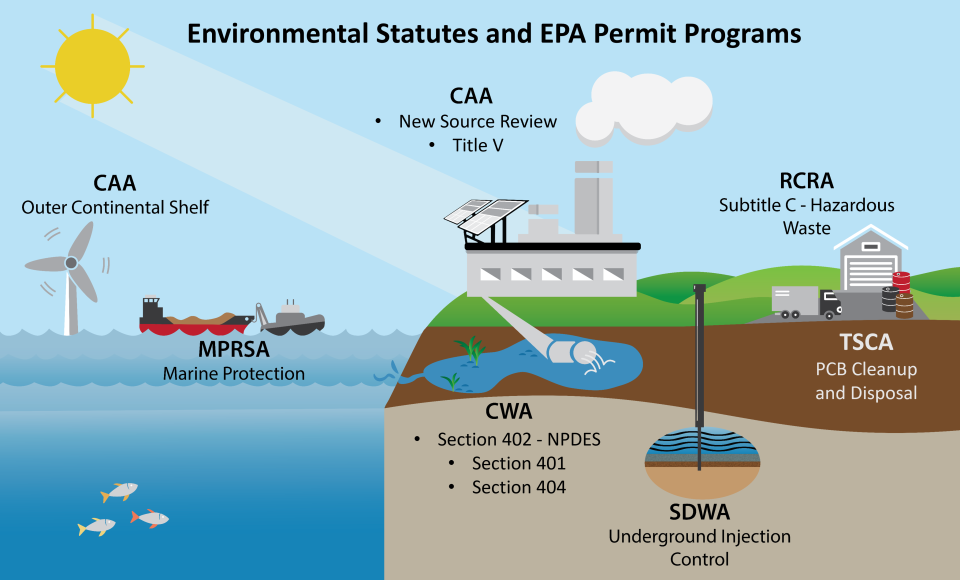About EPA Permitting
EPA’s Role in Permitting
Congress gave EPA the authority to ensure compliance with several environmental statutes that are aimed at protecting public health and America’s air, land and water. One way EPA implements this authority is through environmental permitting programs derived from these statutes and their corresponding regulations. Permits issued under these programs limit emissions, discharges of pollutants and disturbances to the environment. Permits also include conditions for monitoring and reporting, which are key components to protecting public health and the environment within our communities.
EPA permit programs are derived from the following federal statutes:
- Clean Air Act.
- Clean Water Act.
- Safe Drinking Water Act.
- Resource Conservation and Recovery Act.
- Marine Protection, Research, and Sanctuaries Act.
- Toxic Substances Control Act.

This figure depicts environmental statutes and corresponding EPA permit programs (each permit program may include several permit types; specific permit types within these programs are not shown):
- CAA and the Outer Continental Shelf program (air emissions for off-shore oil, gas and wind energy), New Source Review program (air emissions for construction of new stationary facilities) and Title V program (air emissions for operation of industrial/commercial facilities).
- CWA and the Section 402/National Pollutant Discharge Elimination System program (discharge of pollutants into waters), Section 404 program (dredge and fill material in waters/wetlands),and Section 401 program (water quality).
- RCRA and the Subtitle C – Hazardous Waste program (management of hazardous materials).
- TSCA and the Polychlorinated Biphenyl Clean-Up and Disposal program (site contamination PCB clean-up).
- SDWA and the Underground Injection Control program (protection of drinking water related to subsurface injection wells).
- MPRSA and the Marine Protection program (deposition and transportation of materials in the ocean).
Who Issues EPA Permits?
EPA issues permits that require permittees to comply with applicable federal statutes. EPA headquarters and each of our ten regional offices have responsibilities for the execution of permit programs.
Although EPA directly issues some permits, many jurisdictions – such as states, territories, tribal nations and municipalities – are approved to directly implement federal environmental permit programs on EPA’s behalf. This process is referred to as delegation, assumption, authorization or primacy, and in such cases, EPA serves a vital oversight role, including developing standards and guidance for permit programs. Find further detail on the permit programs, permit types and links to pages that provide delegation information on the EPA Permit Programs and Corresponding Environmental Statutes page.
When entities other than EPA administer federal permit programs, their regulations must be at least as stringent as federal regulations. Furthermore, states, territories, tribal nations and municipalities may have their own environmental regulations and permit programs based on their legislation. EPA has a list of state and territory permit programs where additional information is available.
Which Permits Are Needed for My Project?
Each EPA permit program has a dedicated webpage which provides permitting resources, such as types of permits available and whether the permitting authority is EPA. A list of these EPA permit programs and links to their webpages are located on the EPA Permit Programs and Corresponding Environmental Statutes page. EPA recommends that potential permit applicants reach out to the relevant EPA headquarters or regional office or state permitting authority, as appropriate, for additional information on permitting requirements.
EPA Permitting in My Community
EPA’s Geospatial Applications page provides interactive tools that analyze water and land resources, as well as air quality and other factors. These tools may also be helpful in identifying permitted facilities or actions within your community. The following are some of these tools:
- ECHO - An interactive map tool that shows enforcement and compliance history for facilities, some of which have EPA permits.
- EnviroAtlas - An interactive map tool with geospatial data layers including sites with EPA permits.
- Cleanups in My Community - A map and list of hazardous waste cleanup locations and grant areas.
- MyEnvironment - A tool featuring a wide range of information about environmental conditions in an area of your choice.
- NEPAssist – A tool that facilitates the environmental review process and project planning in relation to environmental considerations and EPA facilities.
Regional offices can provide information regarding environmental concerns, proposed projects or facilities in communities, and public notices for specific projects. They can also provide permitting guidance, information on key issues at the state level and emergency contact information. Find EPA regional offices and geographic initiatives.
